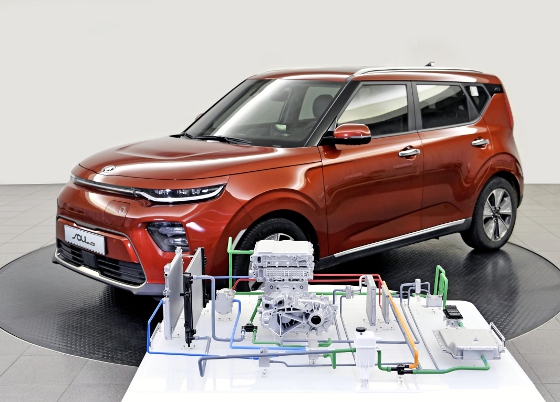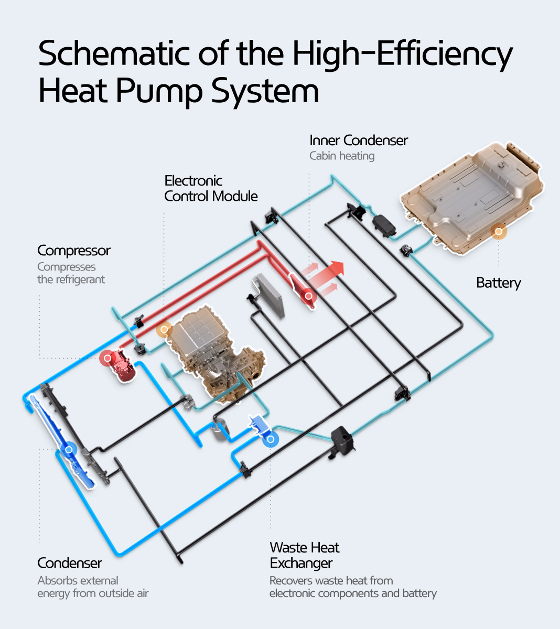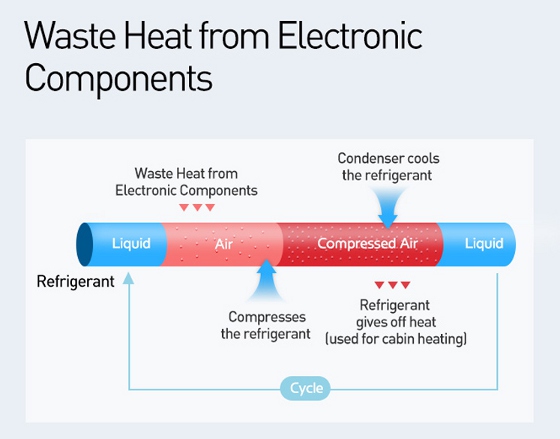 |
| September 22, 2020 | Volume 16 Issue 36 |
Designfax weekly eMagazine
Archives
Partners
Manufacturing Center
Product Spotlight
Modern Applications News
Metalworking Ideas For
Today's Job Shops
Tooling and Production
Strategies for large
metalworking plants
EV Tech: Once-wasted heat now warms cabin, extends winter range

All-electric vehicles from Hyundai and Kia will soon feature a new and improved heat pump system aimed at maximizing driving range in low temperatures. It scavenges waste heat from the electronic and other systems to warm the cabin.
The technology was first introduced in 2014 on the first-generation Kia Soul EV, comprising a compressor, evaporator, and condenser. The heat pump captured waste heat given off by the vehicle's electrical components, recycling this energy to heat the cabin more efficiently. The technology meant the Soul EV's 180-km (112-mile) electric range was protected in cold weather driving conditions.
Since then, the industry-leading heat pump technology has been developed further for new EVs from Hyundai and Kia. It now harvests significantly more energy by recycling additional waste heat not only from power electrics (PE) modules (such as drive motors, on-board chargers, and inverters), but also from the battery pack and slow charger.
The system uses the heat generated by these components to vaporize refrigerant from liquid to gas form. High-pressure gas is discharged from the compressor and forced into a condenser to be converted back into a liquid. This process generates additional heat energy that is recovered by the heat pump and used to warm the cabin.

This captured energy improves the efficiency of the HVAC (heating, ventilation, and air conditioning) system, recycling it to heat up the cabin more efficiently and minimize battery power consumption. By reducing the load on the battery, the heat pump cuts energy consumption from the HVAC system, maximizing the available electric driving range of the car.
Hyundai and Kia continue to develop their heat pump technology to yield even greater improvements in energy capture and efficiency. The system has been gradually refined since its 2014 introduction through extreme cold weather testing in Northern Sweden, where temperatures can get as low as -35 C (-31 F) in the winter. By testing in extreme cold temperatures, research engineers have identified additional ways to recycle as much waste heat as possible to increase the efficiency of the heat pump system. Testing the technology in these conditions ensures the heat pump is capable of operating in even the coldest environments.
The heat pump is one of a number of innovations found in Hyundai and Kia's current generation of EVs, with heat management also used to realize major improvements in EV battery packs.
A water-cooling system for Hyundai and Kia's EV battery packs, rather than conventional air cooling, has yielded further increases in range without increasing physical dimensions. This development means battery cells in Hyundai and Kia EVs can be packaged much more tightly, with water-cooling channels taking up less space than air-cooling channels, increasing battery density by up to 35 percent.

This innovation means the latest EVs from Hyundai and Kia offer around twice as much driving range and battery capacity compared to the their first-generation EVs -- and are capable of travelling significantly farther on a single charge. For example, the first-generation Soul EV offered owners an electric driving range of around 180 km (112 miles) from a single charge of its 30-kWh lithium-ion polymer battery pack. The second-generation Soul EV, with a 64-kWh battery occupying a similar amount of space, is capable of traveling up to 386 km (240 miles) on a single charge.
A study carried out by Korea's Ministry of the Environment on the Hyundai Kona Electric and Kia Niro EVs found that the heat pump significantly reduced battery consumption in cold conditions. When each car was driven in temperatures of -7 C (19 F) with the HVAC system activated, they were able to maintain 90 percent of their driving range compared to journeys undertaken at an ambient 26 C (79 F) -- setting a new benchmark for other EVs. By contrast, many EVs offered by other manufacturers saw their total electric driving range drop by between 18 and 43 percent under the same test conditions.
Under its "Strategy 2025" plan, Hyundai Motor aims to sell 670,000 battery EVs and FCEVs (fuel cell electric vehicles) annually to become a top-three EV manufacturer by 2025. Kia's mid- to long-term strategy, dubbed "Plan S," will see the brand's lineup grow to 11 EVs over the same timeframe.
Source: Kia Motors Corporation
Published September 2020
Rate this article
View our terms of use and privacy policy
